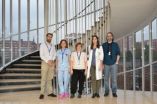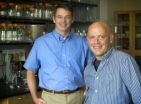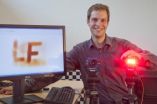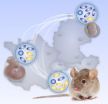(Press-News.org) HEIDELBERG, 17 June 2014 – A specific protein found in the bridge-like structures that make up part of the auditory machinery of the inner ear is essential for hearing. The absence of this protein or impairment of the gene that codes for this protein leads to profound deafness in mice and humans, respectively, reports a team of researchers in the journal EMBO Molecular Medicine.
"The goal of our study was to identify which isoform of protocadherin-15 forms the tip-links, the essential connections of the auditory mechanotransduction machinery within mature hair cells that are needed to convert sound into electrical signals," remarks Christine Petit, the lead author of the study and Professor at the Institut Pasteur in Paris and at Collège de France.
Three types of protocadherin-15 are known to exist in auditory sensory cells of the inner ear but it was not clear which of these protein isoforms was essential for hearing. "Our work pinpoints the CD2 isoform of protocadherin-15 as an essential component of the tip-link and reveals that the absence of protocadherin-15 CD2 in mouse hair cells results in profound deafness."
Within the hair bundle, the sensory antenna of auditory sensory cells, the tip-link is a bridge-like structure that when stretched can activate the ion channel responsible for generating electrical signals from sound. Tension in the tip-link created by sound stimulation opens this channel of unknown molecular composition thus generating electrical signals and, ultimately, the perception of sound.
The researchers engineered mice that lack only the CD2 isoform of protocadherin-15 exclusively during adulthood. While the absence of this isoform led to profound deafness, the lack of the other protocadherin-15 isoforms in mice did not affect their hearing.
Patients who carry a mutation in the gene encoding protocadherin15 are affected by a rare devastating disorder, Usher syndrome, which is characterized by profound deafness, balance problems and gradual visual loss due to retinitis pigmentosa. In a separate approach, the scientists also sequenced the genes of 60 patients who had profound deafness without balance and visual impairment. Three of these patients were shown to have mutations specifically affecting protocadherin-15 CD2. "The demonstration of a requirement for protocadherin-15 CD2 for hearing not only in mice but also in humans constitutes a major step in the objective of deciphering the components of the auditory mechanotransduction machinery. This isoform can be used as a starting point to identify the other components of the auditory machinery. By focusing our attention on the CD2 isoform of protocadherin-15, we can now consider developing gene therapy strategies for deafness caused by defects in this gene," says EMBO Member Christine Petit.
INFORMATION:
The CD2 isoform of protocadherin-15 is an essential component of the tip-link complex in mature auditory hair cells
Elise Pepermans, Vincent Michel, Richard Goodyear, Crystel Bonnet, Samia
Abdi, Typhaine Dupont, Souad Gherbi, Muriel Holder, Mohamed Makrelouf,
Jean-Pierre Hardelin, Sandrine Marlin, Akila Zenati, Guy Richardson, Paul
Avan, Amel Bahloul and Christine Petit
Read the paper:
http://embomolmed.embopress.org/content/early/2014/06/16/emmm.201403976
doi: 10.15252/emmm.201403976
Further information on EMBO Molecular Medicine is available at http://embomolmed.embopress.org/
Media Contacts
Barry Whyte
Head | Public Relations and Communications
barry.whyte@embo.org
Céline Carret
Editor, EMBO Molecular Medicine
Tel: +49 6221 8891 411
celine.carret@embo.org
About EMBO
EMBO is an organization of more than 1600 leading researchers that promotes excellence in the life sciences. The major goals of the organization are to sup-port talented researchers at all stages of their careers, stimulate the exchange of scientific information, and help build a European research environment where scientists can achieve their best work.
EMBO helps young scientists to advance their research, promote their interna-tional reputations and ensure their mobility. Courses, workshops, conferences and scientific journals disseminate the latest research and offer training in tech-niques to maintain high standards of excellence in research practice. EMBO helps to shape science and research policy by seeking input and feedback from our community and by following closely the trends in science in Europe.
For more information: http://www.embo.org
Hearing protein required to convert sound into brain signals
2014-06-17
ELSE PRESS RELEASES FROM THIS DATE:
The American College of Chest Physicians releases updated PAH guidelines
2014-06-17
June 17, 2014, Glenview, Illinois--The American College of Chest Physicians (CHEST) announced today the Online First publication of Pharmacological Therapy for Pulmonary Arterial Hypertension in Adults: CHEST Guideline in the journal CHEST. Pulmonary arterial hypertension (PAH), a rare form of pulmonary hypertension, can strike anyone, but individuals with connective tissue diseases such as scleroderma, liver disease, or HIV infection, are more likely than the general population to have PAH. These new guidelines provide recommendations to help clinicians manage PAH using ...
MIPT develops unique greenhouse gas meter
2014-06-17
Laboratory for the Spectroscopy of Planetary Atmospheres of Moscow Institute of Physics and Technology has come up with a high-resolution meter to gauge the concentration of gases in the atmosphere with unparalleled precision. The infrared spectrum radiometer is described in an article recently published in the journal Optics Express.
The paper, authored by Alexander Rodin, Artem Klimchuk, Alexander Nadezhdinsky, Dmitry Churbanov and Maxim Spiridonov, says that the new spectrum radiometer is 100 times more precise than the best available near-infrared spectrometers, ...
In the quest for safer treatment for systemic lupus erythematosus
2014-06-17
This news release is available in Spanish.
Systemic lupus erythematosus (SLE) is a chronic autoimmune disease. It can affect various organs, in particular, the skin, joints and kidneys although it displays great variability in extent and seriousness depending on the patient. Approximately nine out of every ten patients are female and it appears in one woman in every thousand.
As Dr Guillermo Ruiz-Irastorza, head of the Autoimmune Disease Research Unit of the Hospital Universitario Cruces, explained, traditionally lupus has been treated mostly with glucocorticoids ...
Genetics of sex -- beyond just birds and bees
2014-06-17
BETHESDA, MD – June 17, 2014 – Sex is everywhere in nature. Whether it's a male bird singing to mark his territory or a tiny yeast cell secreting chemicals to attract the opposite mating type, sex has profoundly shaped the appearance, behavior and evolution of many organisms. The genetic and evolutionary forces underlying sex differences and sex determination are crucial for understanding much of the natural world, including human biology.
In recognition of the importance of these topics, the Genetics Society of America journals GENETICS and G3: Genes|Genomes|Genetics ...
The genes behind immunity
2014-06-17
BETHESDA, MD – June 17, 2014 – Immunity is what stops you dying from a common cold or a tiny pinprick. Differences in resistance or tolerance to disease influence who catches the bug that's going around the office, or which species succumb to the deadly fungus devastating frogs around the world. But immunity involves more than just the immune cells that recognize and hunt down pathogens. It is influenced by the host's health, physiology, behavior, and environment. And underlying all these processes and their intricate interactions are the genes that govern their function.
This ...
UT Arlington scientists suggest 'Fragile Y Hypothesis' to explain chromosome loss
2014-06-17
A UT Arlington research team says their study of genetic information from more than 4,000 beetle species has yielded a new theory about why some species lose their Y chromosome and others, such as humans, hang on to it.
They call it the "fragile Y hypothesis."
The biologists' idea is that the fate of the Y chromosome is heavily influenced by how meiosis, or the production of sperm, works in an organism. They believe the size of an area where X and Y genetic information mingle or recombine can serve as a strong clue that a species is at risk of losing the Y chromosome ...
Self-motivated participation in learning activities increases the well-being of adults
2014-06-17
Non-vocational adult education drawing on a person's own motivation comes with a variety of benefits that are also reflected on the person's close friends, family and work. Studying boosts self-confidence and well-being, and expands social networks. Furthermore, motivation to pursue other studies also increases. Thanks to participation in adult education, tolerance towards and confidence in other people grows, and adult learners pay increasing attention to their health. Parents are better able to support the studying of their school-aged children.
All of the above are ...
With light echoes, the invisible becomes visible
2014-06-17
Scientists at the University of Bonn and the University of British Columbia (Vancouver, Canada) have developed a novel camera system which can see around the corner without using a mirror. Using diffusely reflected light, it reconstructs the shape of objects outside of the field of view. The researchers will be reporting their results at the international Conference for Computer Vision and Pattern Recognition (CVPR) from June 24-27 in Columbus (Ohio, USA).
A laser shines on the wall; a camera watches the scene. Nothing more than white ingrain wallpaper with a bright spot ...
Three parents and a baby
2014-06-17
Mitochondria are cell organelles located within animal and human cells. They produce energy for the organism, possess their own genetic material - mitochondrial DNA (mtDNA) - and are transmitted exclusively by the mother. Depending on their activity and tasks, different numbers of mitochondria are present in a cell - usually a few hundred to a thousand per body cell.
Inherited mitochondrial disorders or so-called mitochondropathies occur in about one of 10,000 humans throughout the world. Diseases such as diabetes, stroke, cardiac defects, epilepsy, or muscle weakness ...
Chemical pollution of European waters is stronger than anticipated
2014-06-17
This news release is available in German.
Substantial improvements in freshwater quality by 2015 have been a declared objective of the EU member states, manifesting itself by the requirements of the Water Framework Directive (WFD). A recent study conducted by the Institute for Environmental Sciences Landau together with the Helmholtz Centre for Environmental Research (UFZ) and fellow scientists from France (University of Lorraine and EDF) and Switzerland (Swiss Federal Institute of Aquatic Science and Technology - EAWAG) shows that this target is unlikely to be ...





